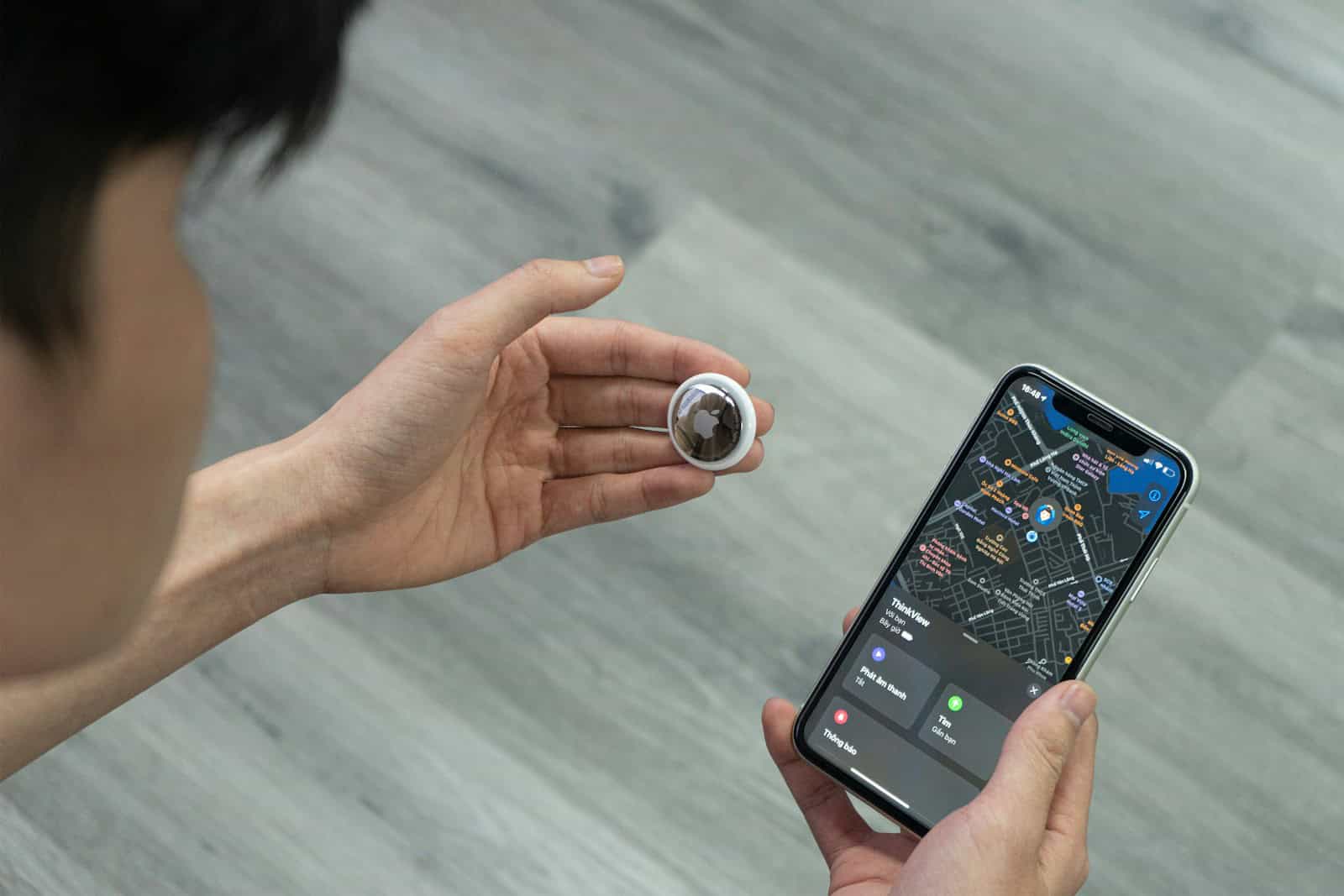
Have you ever felt uneasy about someone knowing your location without your permission? Apple’s AirTags have made tracking items easier, but they’ve also raised privacy concerns. Many people wonder what to do if they find an unknown AirTag following them.
If you discover an unwanted AirTag tracking you, you can disable it by removing its battery, which requires pressing down on the back cover and twisting it counterclockwise to open the device. Before taking this step, you can use your iPhone to identify the AirTag by opening the Find My app, checking for alerts, or using the Precision Finding feature if available on newer iPhone models.
For those concerned about ongoing tracking, turning on Tracking Notifications in your iPhone’s Find My app provides alerts when unknown devices travel with you. Android users can download the Tracker Detect app from Apple to scan for nearby AirTags that might be following them.
1. Recognize the Warning Signs
- iPhone users (iOS 17+): You’ll see an alert like “AirTag Found Moving With You”.
- Android users (2025): Thanks to the joint Apple‑Google unwanted tracker alert system, Android phones now get similar notifications.
- Sound alert: If an AirTag is separated from its owner and moving with you, it will play a beeping sound after a period of time.
2. Use Your Phone to Locate the AirTag
- On iPhone: Tap the notification → it opens Find My, showing the AirTag’s distance and direction.
- On Android: Tap the alert → it opens the built‑in Find My Device network alert tool (no extra app needed in 2025).
- If no notification appears but you suspect tracking, you can use Apple’s Tracker Detect app (Android) or scan for Bluetooth devices.
3. Disable the AirTag
Once you find the AirTag:
- Hold it with the white side facing you.
- Twist counterclockwise to remove the back cover.
- Take out the CR2032 battery → this immediately stops location sharing.
4. Check Ownership
- In the Find My app notification, you may see the AirTag’s serial number and the last four digits of the owner’s phone number.
- If you believe you’re being stalked, do not return the AirTag to the owner. Instead, contact local law enforcement with this information.
5. Report and Stay Safe
- Contact police if you suspect malicious intent.
- Apple can work with authorities to identify the registered owner of the AirTag.
- If you’re in a high‑risk situation, keep the disabled AirTag as evidence.
6. Preventative Tips
- Always keep Bluetooth and Location Services ON (so your phone can detect trackers).
- Update your iPhone or Android to the latest OS version for the newest anti‑tracking protections.
- If you don’t want alerts from a specific AirTag (like a family member’s), you can pause or disable Item Safety Alerts in Find My (source: Apple Support Community).
✅ Summary:
If you get an AirTag notification in 2025, don’t ignore it. Use your phone to locate the tag, physically disable it by removing the battery, and report suspicious cases to authorities.
Key Takeaways
- Remove an AirTag’s battery by twisting its back cover counterclockwise to immediately stop it from tracking you.
- Enable Tracking Notifications in your iPhone’s Find My app settings to receive alerts about unknown tracking devices.
- Android users should download Apple’s Tracker Detect app to scan for and identify potentially unwanted AirTags in their vicinity.
Understanding AirTags and Privacy Concerns
Apple AirTags have become both useful tracking devices for personal belongings and potential tools for unwanted surveillance. Their widespread adoption has raised important questions about balancing convenience with privacy protection.
What is an Apple AirTag?
An AirTag is a small, coin-shaped tracking device created by Apple to help users locate personal items like keys, wallets, or luggage. These devices use Bluetooth technology to communicate with nearby Apple devices on the Find My network.
Each AirTag contains a small speaker that can emit a sound to help locate items. They’re powered by a replaceable CR2032 battery that lasts about a year. AirTags are designed to be attached to personal belongings, not to track people or someone else’s property.
The devices work by pinging their location to nearby iPhones, which anonymously relay this information to the owner through Apple’s Find My network. This system allows users to track items even when they’re far from their own devices.
Privacy Issues Associated with AirTags
The main privacy concern with AirTags is their potential for unwanted tracking. Their small size and affordability make them easy to hide in someone’s belongings or vehicle for stalking purposes.
Apple has implemented several safety features to address these concerns. iPhones will alert users if an unknown AirTag is moving with them. Android users can download the Tracker Detect app to scan for nearby AirTags. Additionally, AirTags will play a sound after being separated from their owner for a period of time.
Despite these safeguards, AirTag stalking incidents continue to occur. Privacy advocates argue that Apple’s anti-stalking measures aren’t sufficient, as alerts can be delayed and sounds can be muffled or disabled.
To improve privacy, Apple has updated AirTags with more prominent warning messages and reduced the time before an unknown AirTag alerts nearby people.
Initial Steps to Stop AirTag Tracking
If you discover an unknown AirTag that might be tracking you, quick action is necessary. There are several methods to identify and disable these devices to protect your privacy.
Identifying an Unknown AirTag
Apple has built-in safety features that alert you when an unknown AirTag is traveling with you. If you have an iPhone, you’ll receive a notification saying “AirTag Found Moving With You.” This alert is part of Apple’s unwanted tracking prevention measures.
To check for more details about the AirTag, tap on the notification. The Find My app will open and show the AirTag’s location history. This can help determine how long it’s been following you.
Android users can download the “Tracker Detect” app from Google Play Store to scan for nearby AirTags. The app will search for any Apple tracking devices separated from their owner.
If you hear an unfamiliar beeping sound, check nearby possessions as this could be an unknown AirTag making its presence known.
Disabling AirTag with Physical Methods
Once an unknown AirTag is found, it can be disabled immediately. The simplest method is to remove the battery:
- Press down and twist the silver back of the AirTag counterclockwise
- Remove the CR2032 battery inside
- This immediately stops the AirTag from reporting its location
Another option is to temporarily pause tracking notifications if the AirTag belongs to a borrowed item. In the alert notification, select “Pause Safety Alerts” for one day.
For permanent protection, users can turn off location services on their device. However, this affects all location-based features, so it’s generally recommended only as a last resort.
If concerned about stalking or harassment, it’s advisable to contact local law enforcement with the AirTag as evidence.
Using Technology to Prevent Unwanted Tracking
Technology offers several ways to protect yourself from unwanted tracking devices like AirTags. These solutions work across different devices and platforms to help maintain your privacy and security.
Leveraging the Find My App’s Safety Features
Apple’s Find My app includes built-in safety features to help users detect unwanted tracking. If you receive an “AirTag Found Moving With You” notification, you can take immediate action. To ensure these alerts work properly, enable Location Services in your iPhone settings under Privacy & Security.
The Find My app allows users to play a sound on the unknown AirTag to locate it physically. This feature works even if the AirTag is hidden in personal belongings or vehicles.
For added protection, users can access Safety Check in Settings > Privacy & Security. This tool helps review and reset access granted to others, including location sharing that might enable tracking.
Before disabling a suspicious AirTag, experts recommend taking screenshots of all alert information as evidence if needed later.
Third-party Apps for Android Phones
Android users aren’t automatically protected against AirTag tracking, but solutions exist. The Tracker Detect app, developed by Apple, allows Android users to scan for nearby AirTags or Find My network accessories that might be traveling with them.
To use Tracker Detect effectively:
- Install from the Google Play Store
- Open the app and scan for nearby devices
- Follow on-screen instructions if a tracker is detected
- Play a sound to help locate the physical device
Other third-party Bluetooth scanner apps can detect nearby devices, though they may not identify AirTags specifically. These apps scan for all Bluetooth signals in the vicinity, requiring users to investigate suspicious devices manually.
Android users should perform regular scans in locations where privacy is important, such as homes and vehicles.
Understanding Bluetooth Security Measures
Bluetooth technology powers AirTags and similar trackers, making it important to understand basic Bluetooth security. Most tracking devices broadcast signals consistently, which makes them detectable with the right tools.
Users can temporarily disable Bluetooth on their phones when in sensitive locations. This doesn’t prevent tracking but stops the phone from interacting with nearby trackers.
For persistent concerns, Bluetooth signal detectors are available as standalone devices. These can identify any Bluetooth emissions nearby, including those from trackers.
Some advanced users employ signal jamming techniques, though these methods may have legal restrictions in many jurisdictions. A safer alternative is using Faraday bags or pouches that block all wireless signals when privacy is critical.
Regular Bluetooth scans combined with physical inspection of belongings provide the most comprehensive protection against unwanted tracking devices.
Best Practices for Personal Tracking Prevention
Protecting yourself from unwanted tracking requires both awareness and proactive measures with your devices. These strategies can help maintain your privacy and reduce the risk of being tracked without your knowledge.
Enhancing General Device Security
To strengthen protection against unwanted tracking, users should regularly update their device’s operating system. Both Apple and Android devices receive security patches that improve anti-tracking features.
For iPhone users, ensuring Location Services is properly configured is essential. Go to Settings > Privacy & Security > Location Services and review which apps have access to your location.
Android users should install the “Tracker Detect” app from the Google Play Store to scan for nearby AirTags. This provides similar protection to what iPhone users have built-in.
Password-protecting all devices prevents unauthorized access to tracking settings. Users should also:
- Enable two-factor authentication on all accounts
- Regularly check for unfamiliar devices in Find My app
- Inspect personal belongings when receiving tracking alerts
- Physically disable any found AirTags by removing the battery
Managing Notifications for Nearby Devices
iPhone users automatically receive notifications about unknown AirTags traveling with them. These alerts are crucial and should never be disabled permanently.
If receiving an alert about a borrowed item with an AirTag, users can temporarily pause notifications for one day. This prevents repeated alerts for legitimate tracking situations.
Notification settings can be found in:
- iPhone: Settings > Privacy & Security > Location Services > Find My
- Android: Through the Tracker Detect app settings
Users should ensure their phone volume is turned up to hear tracking alerts. Silent or Do Not Disturb modes might suppress important tracking warnings.
For shared items like family car keys, users can register AirTags as “approved” to prevent false alarms while maintaining security against unknown trackers.
Legal Recourse and Privacy Rights
If you discover an AirTag tracking you without consent, you have legal rights and options. Understanding your privacy protections and knowing how to properly report tracking incidents are essential steps in protecting yourself from unwanted surveillance.
Understanding Your Legal Protections
Using tracking devices like AirTags to monitor someone without their knowledge or consent can be illegal. Many states have specific laws against stalking with GPS devices, which can result in felony charges and up to five years in prison for offenders.
Privacy laws protect individuals from unauthorized tracking. Apple has acknowledged these concerns and has implemented additional safety features to prevent misuse of their products.
Users should be aware that placing an AirTag in someone else’s property without permission could lead to both criminal and civil penalties. The legal implications vary by location, but courts generally recognize unauthorized tracking as an invasion of privacy.
Reporting Unauthorized Tracking
If you find an unwanted AirTag, document everything before taking action. Take photos of the device and note where and when you found it.
Contact local law enforcement immediately and file a formal police report. This creates an official record of the incident that may be necessary for further legal action.
For Apple users, enabling Location Services under Privacy & Security settings is crucial as it allows your device to detect unwanted tracking. When an unknown AirTag is detected, follow Apple’s on-screen instructions to disable it.
Consider consulting with an attorney, especially if you can identify who placed the tracking device. Legal professionals can advise on potential restraining orders or civil lawsuits depending on your specific situation.
Manufacturer-Specific Considerations
Different device manufacturers offer varying approaches to detecting and managing unwanted tracking devices. The methods for stopping AirTag tracking depend on your specific device ecosystem and settings.
Guidance for Apple Devices
Apple has built several safety features directly into its ecosystem to prevent unwanted tracking with AirTags. iPhone users running iOS 14.5 or later will automatically receive tracking notifications if an unknown AirTag is moving with them over time.
To ensure these alerts work properly:
- Keep Bluetooth and Location Services turned on
- Make sure airplane mode is disabled
- Update to the latest iOS version
If an alert appears, users can tap it to make the AirTag play a sound to help locate it. The notification also provides options to disable the AirTag. For personal AirTags that trigger false alerts, users should ensure the device is properly registered to their Apple ID.
Apple has reduced the time before an unwanted AirTag makes a sound from three days to a random time between 8-24 hours, improving safety.
Tips for Android Users
Android devices don’t natively detect AirTags, but Google has implemented tracking protection. Users can disable “Trackable Tag Detected” notifications in Google Play settings for their own devices.
To manage unwanted tracking:
- Download the “Tracker Detect” app from Apple on Google Play
- Open the app and scan for nearby trackers
- Follow instructions to disable any found devices
Android users should periodically check for unknown Bluetooth devices, especially after visiting new locations. The Tracker Detect app requires manual scanning, unlike the automatic detection on iPhones.
Some Android phones now have built-in tracking detection in their security settings, especially newer models running Android 13 or higher.
Vehicle Systems and AirTag Compatibility
Modern vehicles from manufacturers like Ford, GM, and Volvo increasingly feature Bluetooth connectivity that could potentially interact with nearby AirTags. This creates both safety opportunities and concerns.
Some considerations for vehicle owners:
- Luxury cars (Audi, Jaguar): Often have advanced Bluetooth systems that may detect nearby trackers
- Ford and GM vehicles: Newer models with FordPass or MyChevrolet apps may alert to unknown tracking devices
- Privacy settings: Check vehicle infotainment system settings for Bluetooth discovery options
Car owners should be aware that metal components and electronics can sometimes interfere with AirTag signals, making detection more difficult. The only way to completely stop an AirTag from broadcasting is to remove its battery.
Frequently Asked Questions
AirTag tracking concerns often arise unexpectedly, requiring quick action. These common questions address specific scenarios users face when dealing with unwanted tracking and provide practical solutions.
What steps can be taken if your iPhone notifies you that an unknown AirTag is nearby?
When an iPhone alerts about an unknown AirTag, users should first tap the notification to see more details. This opens the Find My app showing the AirTag’s location history.
Users can make the AirTag play a sound to help locate it physically. This feature is accessible through the alert notification or within the Find My app.
After finding the AirTag, it can be disabled by removing its battery. Simply twist the metallic back counterclockwise and remove the CR2032 battery inside.
If the AirTag belongs to a borrowed item, users can choose to pause tracking alerts for one day.
How can one prevent an AirTag from tracking their location on an Android device?
Android users can download the “Tracker Detect” app from Google Play Store. This app scans for nearby AirTags not associated with the user’s Apple ID.
When a suspicious AirTag is detected, Android users can make it play a sound to locate it physically. The process takes about 10 minutes of proximity to trigger detection.
Android users should regularly scan their belongings and surroundings if they suspect tracking. Unlike iPhones, Android devices don’t automatically notify about nearby AirTags.
What actions should be taken when you receive an ‘AirTag Found Moving With You’ alert but cannot locate the AirTag?
Users should carefully check all personal belongings, focusing on less obvious places like coat pockets, bag compartments, and vehicle spaces. The alert means the AirTag has been moving with you for some time.
Use the sound feature from the alert to help locate the device. The sound can penetrate through fabric and some thin materials.
If the AirTag remains hidden despite thorough searching, consider visiting a police station or seeking help from security professionals who may have specialized equipment to detect it.
How does one disable or silence the ‘AirTag detected near me’ alert on their device?
Currently, Apple doesn’t offer a way to completely disable AirTag tracking notifications, as they’re a safety feature. However, users can pause notifications for a specific AirTag for one day.
To temporarily silence alerts, tap the notification, select the identified AirTag, and choose “Pause Safety Alerts” for one day.
For legitimate situations where an AirTag belongs to a family member or friend, users can ask the owner to add them to their Family Sharing group, which prevents unwanted alerts.
What are the recommended measures to ensure personal privacy against unwanted AirTag tracking?
Regularly check belongings when in public spaces, especially after attending crowded events. This simple habit can help detect unwanted tracking devices early.
Keep iPhone software updated to ensure the latest tracking detection features are active. Apple frequently improves these security features.
In extreme situations, users can temporarily disable Location Services by going to Settings > Privacy & Security > Location Services. However, this impacts many useful app functions.
Consider using Bluetooth scanning apps that can detect all nearby Bluetooth devices, which might help identify suspicious devices beyond just AirTags.
Is it possible to make an AirTag undetectable, and if so, how?
It is not officially possible to make an AirTag completely undetectable, as this would defeat Apple’s anti-stalking safety features. Any modifications attempting this violate Apple’s terms of service.
Apple designed AirTags with safety protocols that make them beep after being separated from their owner for 8-24 hours. These features cannot be legitimately disabled.
Physical tampering with an AirTag to remove its speaker is illegal when done for stalking purposes and significantly damages the device’s functionality.






